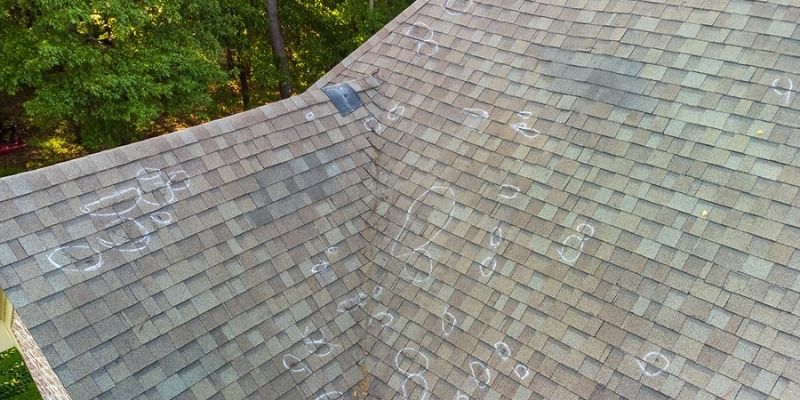One of the most common problems homeowners face with their asphalt shingle roofs is granule loss or decay. Those granules serve a vital purpose – they protect the asphalt coating on the shingles from the sun’s harmful UV rays. When those granules start to deteriorate and wash away, it leaves the shingles exposed and vulnerable to premature aging and failure.
Granule decay is a natural part of the shingles’ life cycle, but there are several factors that can accelerate the rate at which it occurs. In this article, we’ll explore some of the key reasons why roof shingles lose their outer granule coating faster than they should. From manufacturing defects to improper installation and severe weather exposure, understanding these causes is crucial for protecting your roofing investment.
Whether you’ve already noticed bare patches on your roof or want to get ahead of potential problems, read on to learn more about granule decay and what you can do to prevent it. With the right knowledge and maintenance, you can help extend the lifespan of your roof shingles and avoid costly premature replacements.
1. Manufacturing Defects
Not all shingle manufacturing is created equal. Defects can occur during the manufacturing process which leaves shingles more vulnerable to premature granule loss. Potential issues include inconsistent or insufficient asphalt coating, improper embedment of granules into the asphalt, and low-quality granule materials.
Inconsistent asphalt means some shingle areas need more bonding to keep granules adhered. Granules that aren’t fully embedded can wash away more easily. And lower-quality granules themselves may degrade and break off sooner under UV and weather exposure. Reputable manufacturers have tighter quality control, but cheaper shingle brands from overseas are more prone to these types of defects.
2. Improper Installation
How shingles are installed plays a big role in their long-term granule adhesion. Improper nailing that leaves shingles unsealed can allow moisture infiltration that loosens granules. Sealant defects or lack of adhesive also reduce the bonding strength.
Shingles that don’t have proper overlap and are too flat may prematurely lose granules to rain runoff and wind. An experienced roofer following manufacturer installation guidelines can help maximize shingle lifespan.
3. Age of Roof
It’s natural and expected for granule loss to occur as roof shingles age, even in ideal conditions. The aging asphalt becomes less flexible and binding over time. Most shingles are rated for 20-30 years, and homeowners can expect accelerated granule shedding during the final 5-10 years of the roof’s service life.
Shingles past their prime require extra maintenance and may need replacing sooner if bare spots spread across a majority of the roof surface area. Tracking the roof age helps anticipate when granule decay will be an issue.
4. Severe Weather
Extreme weather takes a major toll on shingles and is one of the leading culprits behind premature granule decay. Heavy snowfall weighs shingles down while the freeze/thaw cycle creates damaging expansion and contraction. Hailstorms can instantly dislodge granules through impact forces.
High winds also scour away granules over time, while intense heat further deteriorates the asphalt bonding. The more frequent and severe weather events a roof endures, the faster its granule coating will erode. Areas prone to snowstorms, hail or sustained temperature extremes often see shorter shingle lifespans.
5. Foot Traffic
Granules are easily dislodged by the impact and scuffing of foot traffic on roof shingles. Repeated trips across a rooftop grind away granules over time. This can create obvious bare spots in areas like around chimney access or roof-mounted HVAC units where foot traffic is concentrated.
It’s best to avoid any unnecessary foot traffic, especially on older roofs. When it can’t be prevented, installers and maintenance crews should use thick walkway pads to disperse their weight and reduce granule loss friction.
6. Tree Debris
Nearby tall trees can bombard shingles with falling leaves, pine needles, fruits, seeds, and twigs over time. This type of organic debris acts like sandpaper scrubbing away granules each time the wind blows across the roof surface. Trees that hang directly over the roof are the biggest culprits.
Maintaining a buffer between the roof and overhanging trees helps minimize this abrasive impact. It’s also critical to routinely clear away debris that accumulates rather than letting it grind away more granules over time.
7. Algae Growth
Algae, moss, lichens, and fungi gradually loosen granules as the organisms grow and “eat” into the asphalt coating. The organisms simultaneously leave dark streaks or discoloration from their spores. Once algae growth takes hold it’s difficult to fully eliminate.
In humid climates with high moisture levels, preventing algae is of utmost importance to preserve shingle granules. Zinc or copper ridge vent strips can help impede new growth, while sodium carbonate cleaning helps eliminate existing algae infestations.
8. Attic Ventilation Issues
Poor attic ventilation creates a moisture trap where hot humid air stagnates against the roof deck underside. This concentrated humidity exposure causes asphalt shingles to soften, curl, and lose adhesion to their granule coating more rapidly.
Promoting proper airflow through the attic space is key. It requires an equal balance of intake soffit vents and exhaust ridgetop/gable vents to constantly cycle fresh air underneath the roof deck. This helps preserve the lifespan and condition of shingles by minimizing heat/moisture buildup.
9. Shingle Quality
The quality of shingle materials has a direct effect on the rate of granule loss over time. Lower-cost shingles use less asphalt filler coating and lower quantities of granule coverage to reduce manufacturing expenses. While they initially look the same, this leaves less material to withstand the years of UV radiation and weather erosion.
Investing in higher quality dimensional or architectural shingles may cost more upfront, but the thicker asphalt layers and deeper granules help maximize the longevity of the rooftop granule protection. Over decades, the cheaper upfront shingle costs have been negated by premature replacements needed for basic 3-tab shingles.
10. Roof Slope
The angle or slope pitch of the roof affects how rapidly granule decay occurs in a few key ways. Lower slopes have shallower inclines that allow leaves, water, and sediment to accumulate rather than swiftly shedding away.
This collected debris acts like sandpaper eroding the surface granules. Steeper pitches over slants are more prone to impact granule removal from hail, branches, and airborne objects as well. A moderate pitch is often considered the ideal slope for maximizing shingle granule longevity.
Conclusion
As you can see, there are many different factors that can accelerate granule loss on asphalt shingles over time. From manufacturing defects and shoddy installation to harsh weather and debris impacts – granule decay is an ongoing threat to be aware of.
While gradual granule shedding is a natural part of shingle aging, premature or excessive granule loss leaves roofing exposed and vulnerable to costlier damage. Staying vigilant about the causes and taking proactive maintenance steps is key to maximizing your roof’s lifespan.
Make regular inspections a priority to check for problem areas and catch issues early before granule decay spreads. Keep trees trimmed back, ensure proper attic ventilation, and invest in quality shingles designed to resist granule erosion. With some diligence, you can protect your roofing investment and avoid premature shingle replacement expenses.
If you do spot widespread thinning of the granule coating, it may be time to consider reroofing before leaks and moisture infiltration occur. An experienced roofing contractor can evaluate your shingles’ condition and provide guidance on timing for a full roof replacement. Don’t let excessive granule decay compromise the structural integrity of your home!

